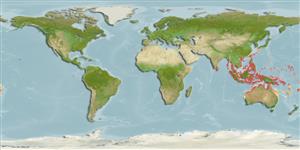Klassifizierung / Names
Namen | Synonyme | Catalog of Fishes(Gattung, Arten) | ITIS | CoL | WoRMS | Cloffa
>
Beloniformes (Needle fishes) >
Hemiramphidae (Halfbeaks)
Etymology: Hemiramphus: Greek, hemi = half + Greek, rhamphos = bill, peak (Ref. 45335).
More on authors: Weber & deBeaufort.
Issue
Issue on validity of subspecies: the subspecies Hemiramphus convexus bruuni is elevated at species rank as Hemiramphus bruuni (Parin, Collette & Shcherbachev, 1980) in Eschmeyer (CofF ver. May 2011: Ref. 86870). The species page will be created.
Environment: milieu / climate zone / depth range / distribution range
Ökologie
seewasser; tiefenbereich 0 - 6 m (Ref. 86942). Tropical
Indo-West Pacific: widespread in warmer waters from East Africa to Caroline Islands, New Guinea, New Britain and New Ireland. Replaced in the Red Sea, Arabian Sea and coastal waters in between by Oxyporhamphus convexus bruuni (Ref. 9843).
Length at first maturity / Size / Gewicht / Alter
Maturity: Lm ?, range 14 - ? cm
Max length : 23.0 cm TL Männchen/unbestimmt; (Ref. 10943); 17.6 cm SL (female)
Rückenflossenstacheln (insgesamt): 0; Rückenflossenweichstrahlen (insgesamt): 12-15; Afterflossenstacheln 0; Afterflossenweichstrahlen: 14 - 16; Wirbelzahl: 48 - 51. Swim bladder composed of many small compartments instead of a single chamber. Gill rakers on the first arch, 26-33, usually 27-31.
More coastal than O. m. micropterus and frequently found near islands.
Life cycle and mating behavior
Geschlechtsreife | Fortpflanzung | Ablaichen | Eier | Fecundity | Larven
Collette, B.B. and J. Su, 1986. The halfbeaks (Pisces, Beloniformes, Hemiramphidae) of the Far East. Proc. Acad. Nat. Sci. Philadelphia 138(1):250-301. (Ref. 10943)
IUCN Rote Liste Status (Ref. 130435)
Bedrohung für Menschen
Harmless
Nutzung durch Menschen
Fischereien: weniger kommerziell
Mehr Information
ReferenzenAquakulturAquakultur ProfilZuchtlinienGenetikElectrophoresesVererbbarkeitKrankheitenVerarbeitungNutrientsMass conversion
PartnerBilderStamps, Coins Misc.LauteCiguateraGeschwindigkeitSchwimmstilKiemenoberflächeOtolithsGehirngrößeSehfähigkeit
Tools
Zusatzinformationen
Download XML
Internet Quellen
Estimates based on models
Preferred temperature (Ref.
123201): 25.3 - 29.3, mean 28.7 °C (based on 2285 cells).
Phylogenetic diversity index (Ref.
82804): PD
50 = 0.5005 [Uniqueness, from 0.5 = low to 2.0 = high].
Bayesian length-weight: a=0.00437 (0.00193 - 0.00988), b=3.08 (2.90 - 3.26), in cm total length, based on LWR estimates for this Genus-body shape (Ref.
93245).
Trophic level (Ref.
69278): 3.3 ±0.5 se; based on size and trophs of closest relatives
Generation time: 0.9 ( na - na) years. Estimated as median ln(3)/K based on 1
growth studies.
Widerstandsfähigkeit (Ref.
120179): hoch, Verdopplung der Population dauert weniger als 15 Monate. (K>1).
Fishing Vulnerability (Ref.
59153): Low vulnerability (13 of 100).
